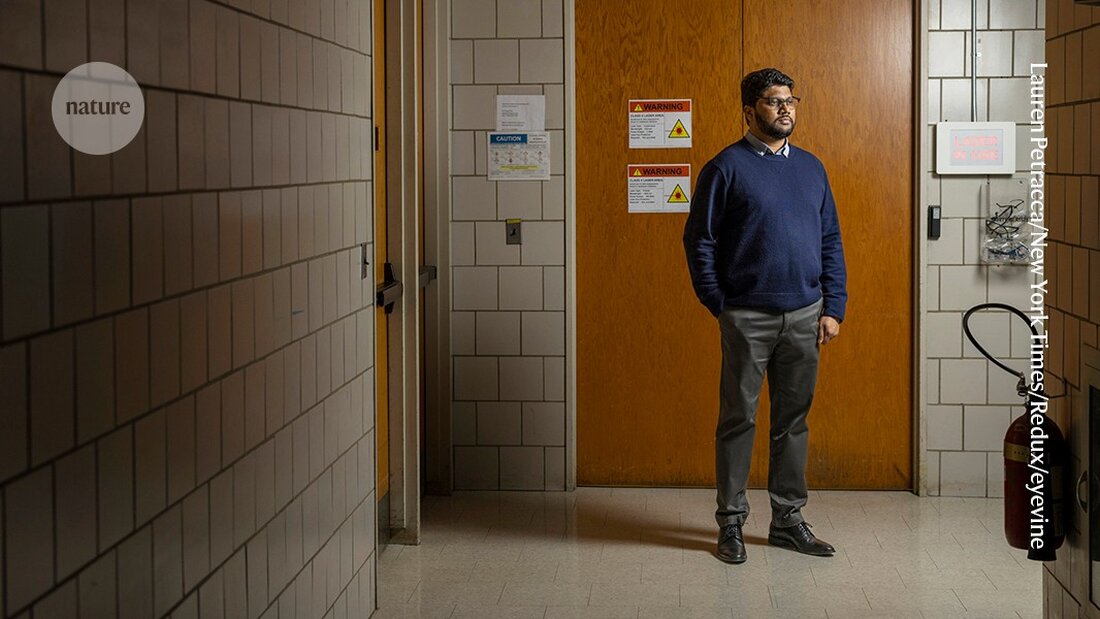Research on superconductivity: Scientist with misconduct leaves university
Superconductivity researcher Ranga Dias is leaving the University of Rochester following revelations of serious misconduct.

Research on superconductivity: Scientist with misconduct leaves university
Ranga Dias, once a promising star in the field of superconductivity, has been embroiled in a public scandal for two years and is no longer employed by his university.
Dias claimed he had Superconductors discovered – materials where electrons can flow without resistance – which should work under high pressure and at room temperature. Previous materials of this type only worked at ultra-low temperatures, which was impractical for use in real devices. These supposed breakthroughs catapulted Dias to fame and earned him millions in research funding. However, after physicists examined the extraordinary results and raised concerns with the journals in which they were published several of Dias' papers retracted. An investigation by the University of Rochester in New York, where Dias was employed, concluded that he had committed extensive misconduct, including data falsification.
The Wall Street Journal and Nature's News Team previously reported that university administration had recommended that Dias, who had no tenure, be fired before his contract expired in June 2025. Dias is now no longer at the university, although the university declined to clarify whether he was fired. “Ranga Dias is no longer an employee of the University of Rochester and has no research activities associated with the university,” a university spokesperson said in a statement. Dias did not respond to a request for comment.
The Dias scandal cast a shadow over the field of high-pressure superconductivity, but particularly affected his former graduate students, who commented on Nature but wished to remain anonymous out of concern for their careers. “I am relieved that we finally have clarity on this issue, although I am very disappointed that it took so long,” one of them said. They added that they "await a public statement from the University of Rochester outlining what policies have failed" that have allowed the controversy to last so long.
A university spokesperson said the university supports students “affected by Ranga Dias’ research misconduct” and that it is “reviewing and updating our research misconduct policies.”
Under investigation
Dias started as a professor at the University of Rochester in 2017, fresh from a postdoctoral fellowship at Harvard University in Cambridge, Massachusetts, where he claimed to have created metallic hydrogen. In theory, when hydrogen is compressed to pressures above the center of the Earth, it should transform from an insulating gas into a superconducting metal. The results have never been reproduced, and many scientists doubted this.
At the University of Rochester, Dias turned his attention to other high-pressure superconductors. In September 2020 he published a groundbreaking study in Nature 1, which claimed that a compound of carbon, sulfur and hydrogen (CSH) is a superconductor at room temperature. And in March 2023 he published another one in Nature 2, which found that a compound of lutetium, hydrogen and nitrogen is a superconductor at room temperature at pressures 100 times lower than CSH - conditions that are even more practical for commercial use. (Nature's news team operates independently of the journal team.)
After the publication of the first paper, Dias' star rose and Rochester doubled his salary. At the same time, Jorge Hirsch, a theorist at the University of California, San Diego, posed questions that led to three studies at the university. However, none found evidence of wrongdoing. Meanwhile, the editors of the journal Nature retracted the CSH paper after bringing in independent specialists to review it, and those specialists found evidence of data falsification.
Data in the 2023 paper also raised questions in the research community, and Dias' former graduate students contacted the Nature team this year with concerns about the validity of the results. It was withdrawn in November.
One investigator, James Hamlin, a high-pressure physicist at the University of Florida in Gainesville, took his concerns to the National Science Foundation (NSF, one of the main funders of science in the US, which awarded Dias grants). At the direction of the NSF, Rochester launched a comprehensive misconduct investigation.
Three outside investigators hired by the university found that Dias had most likely committed research misconduct in 16 of 16 allegations they examined. NSF public records show that a grant awarded by the agency to Dias worth about $800,000 was canceled after the investigation was completed.
Researchers shared their thoughts on Dias' departure from Rochester with the news team. “Did the system work?” asks Peter Armitage, a condensed matter researcher at Johns Hopkins University in Baltimore, Maryland. “Yes, ultimately, but many institutions failed us along the way.” He points out that Rochester missed problems in early research and that Nature published a second paper by Dias after the first was retracted.
Nature's journal team declined to comment.
Case closed?
Dias has the validity of his superconductivity research on social media claims, but does not publish any further evidence to support it. And independent teams have been unable to reproduce the findings since the Rochester investigation was released. In June, another of Dias's papers, published in the journal Physical Review Letters and claiming to have created another high-temperature, high-pressure superconductor, was retracted 3. This brings the number of his withdrawals to five.
What Dias will do now remains unclear, but according to reports from the Rochester Democrat and Chronicle Dias continues to work at Unearthly Materials, his Rochester-based company that aims to develop novel superconductors. In 2022, the company received $15 million in funding from London-based venture capital group Plural. A spokesman for Plural declined to comment on Dias' misconduct, and after receiving questions from the Nature news team for this story, references to Dias disappeared from the company's website.
-
Snider, E. et al. Nature 586, 373–377 (2020); Withdrawal 610, 804 (2022).
-
Dasenbrock-Gammon, N. et al. Nature 615, 244–250 (2023); Withdrawal 624, 460 (2023).
-
Snider, E. et al. Phys. Rev. Lett. 126, 117003 (2021); Withdrawal 132, 249901 (2024).

 Suche
Suche
 Mein Konto
Mein Konto
